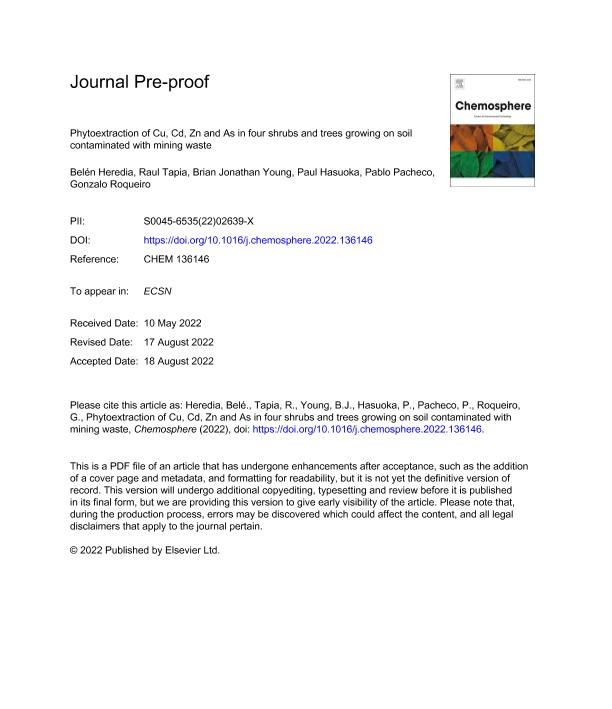Artículo
Phytoextraction of Cu, Cd, Zn and As in four shrubs and trees growing on soil contaminated with mining waste
Heredia, Tatiana Belén ; Tapia Balmaceda, Raúl Esteban
; Tapia Balmaceda, Raúl Esteban ; Young, Brian Jonathan; Hasuoka, Paul Emir
; Young, Brian Jonathan; Hasuoka, Paul Emir ; Pacheco, Pablo Hugo
; Pacheco, Pablo Hugo ; Roqueiro, Gonzalo
; Roqueiro, Gonzalo
 ; Tapia Balmaceda, Raúl Esteban
; Tapia Balmaceda, Raúl Esteban ; Young, Brian Jonathan; Hasuoka, Paul Emir
; Young, Brian Jonathan; Hasuoka, Paul Emir ; Pacheco, Pablo Hugo
; Pacheco, Pablo Hugo ; Roqueiro, Gonzalo
; Roqueiro, Gonzalo
Fecha de publicación:
08/2022
Editorial:
Pergamon-Elsevier Science Ltd
Revista:
Chemosphere
ISSN:
0045-6535
Idioma:
Inglés
Tipo de recurso:
Artículo publicado
Clasificación temática:
Resumen
Mining activity has degraded large extensions of soil and its waste is composed of metals, anthropogenic chemicals, and sterile rocks. The use of native species in the recovery of polluted soils improves the conditions for the emergence of other species, tending to a process of ecosystem restoration. The objective of this study was to evaluate the bioaccumulation of metal(loid)s in four species of native plants and the effect of their distribution and bioavailability in soil with waste from an abandoned gold mine. Soil samples were taken from two sites in La Planta, San Juan, Argentina: Site 1 and Site 2 (mining waste and reference soil, respectively). In Site 1, vegetative organ samples were taken from Larrea cuneifolia, Bulnesia retama, Plectrocarpa tetracantha, and Prosopis flexuosa. The concentration of metal(loid)s in soil from Site 1 were Zn > As > Cu > Cd, reaching values of 7123, 6516, 240 and 76 mg kg−1, respectively. The contamination indices were among the highest categories of contamination for all four metal(loid)s. The spatial interpolation analysis showed the effect of the vegetation as the lowest concentration of metal(loid)s were found in rhizospheric soil. The maximum concentrations of As, Cu, Cd and Zn found in vegetative organs were 371, 461, 28, and 1331 mg kg−1, respectively. L. cuneifolia and B. retama presented high concentrations of Cu and Zn. The most concentrated metal(loid)s in P. tetracantha and P. flexuosa were Zn, As and Cu. Cd was the least concentrated metal in all four species. The values of BAF and TF were greater than one for all four species. In conclusion, the different phytoextraction capacities and the adaptations to arid environments of these four species are an advantage for future phytoremediation strategies. Their application contributes to the ecological restoration and risk reduction, allowing the recovery of ecosystem services.
Archivos asociados
Licencia
Identificadores
Colecciones
Articulos(CCT - MENDOZA)
Articulos de CTRO.CIENTIFICO TECNOL.CONICET - MENDOZA
Articulos de CTRO.CIENTIFICO TECNOL.CONICET - MENDOZA
Articulos(INQUISAL)
Articulos de INST. DE QUIMICA DE SAN LUIS
Articulos de INST. DE QUIMICA DE SAN LUIS
Citación
Heredia, Tatiana Belén; Tapia Balmaceda, Raúl Esteban; Young, Brian Jonathan; Hasuoka, Paul Emir; Pacheco, Pablo Hugo; et al.; Phytoextraction of Cu, Cd, Zn and As in four shrubs and trees growing on soil contaminated with mining waste; Pergamon-Elsevier Science Ltd; Chemosphere; 308; 8-2022; 1-40
Compartir
Altmétricas



